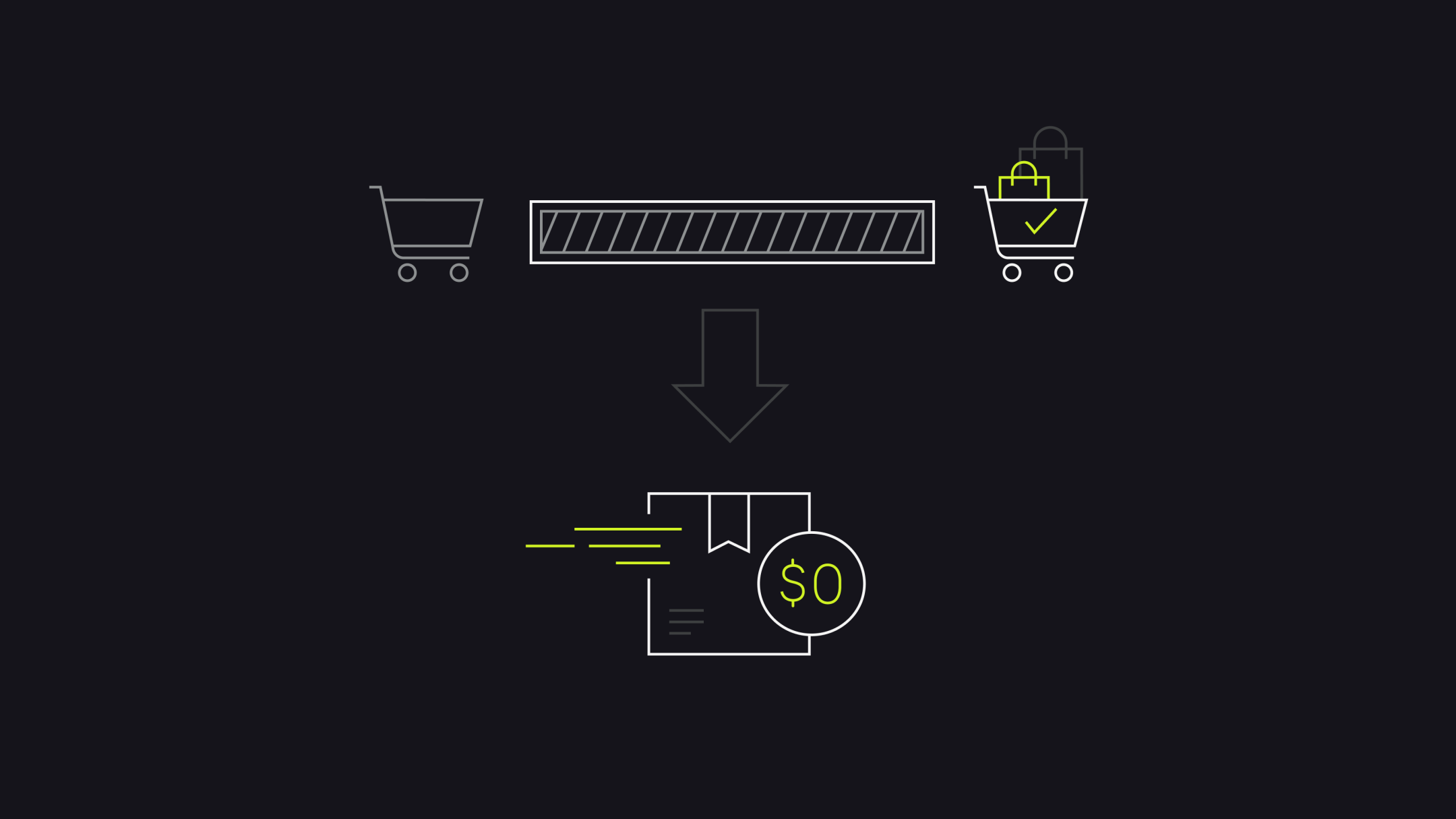Unless you're a bubble wrap enthusiast, chances are the topic of shipping doesn’t get you too excited. It might just feel like the last hurdle to get your products into the hands of your customers.
But for shoppers, shipping is one of the most important parts of the online shopping experience—it’s often what dictates whether they’ll make a purchase or abandon their cart.
For the last 15 years, research has continued to demonstrate that the cost of shipping remains one of the top factors influencing purchasing decisions, followed by return policies and shipping speed. It’s estimated that over 40% of consumers research delivery costs when shopping online. The magic number they’re looking for? $0.
Online consumers increasingly want and expect their shipping to be offered for free. According to Shopify’s research, 59% of consumers say that free delivery improves their online shopping experience—while 67% of those in the United States say that it’s “crucial” to their online shopping experience.
For fast-growing brands, free shipping is an opportunity to both reduce cart abandonment and improve conversion rates. Here’s why free shipping matters—and how to offer it without eating into your profit margins.
Don't have time to read the full article? We brought in the experts from Deloitte, 6 River Systems, and UPS to share best practices for supply chain and logistics management during a pandemic. Watch the webinar
Table of Contents:
- Why free shipping matters in ecommerce
- How to offer two-day shipping on Shopify
- How to calculate free shipping thresholds
- Should I offer free shipping or a discounted price on a product?
- Don't forget to revisit your shipping policies
- Doubling your margins with a box
- Optimizing average box size
- Creating your own free shipping program
- Optimizing shipping by outsourcing to a 3PL
- How geography impacts shipping costs
- How Rhone builds bundles to scale faster and efficiently
- How The Emazing Group optimizes packaging
- How Bathorium cuts shipping costs by 70%
Why free shipping matters in ecommerce
Customers now expect free shipping—and free returns.
Once upon a time, free shipping was a competitive point of difference. Those days are long gone. Free shipping is now the norm, with the majority of online retailers promoting it. Of the brands in Internet Retailer’s 2019 Top 1,000, more than 65% offered free shipping on at least some orders, while 17.5% offered free shipping on all products. This number is even higher for brands selling their products on Shopify; in 2020, 75% had free shipping enabled on their stores.
The result is that customers now expect free shipping. According to a National Retail Federation (NRF) study, 75% of consumers expect delivery to be free even on orders under $50. And if it’s not offered? They’re happy to walk away.
Unexpected added costs—such as shipping fees—are frequently cited as one of the main reasons why shoppers abandon carts. In a 2019 survey of nearly 1,000 American online shoppers, 68% said they didn’t make a purchase at least half of the time when the retailer didn’t offer free shipping, and 22% abandon their carts as a result of “slow shipping.”
Not only do customers expect fast and free free shipping, they also look for brands who offer free return policies. This, however, comes with a word of caution: A 2020 study published in the Journal of Marketing Research found that free shipping combined with free returns promotions encouraged consumers to make “riskier purchases.” While this increased net sales volume, it resulted in higher product returns and lost shipping revenue, “rendering these promotions unprofitable.”
Learn more:
Free shipping may lead to increased orders and a higher average order value (AOV)
Simply put, there is no such thing as “free” shipping. If the customer doesn’t pay for delivery, you’ll have to. But done right, absorbing this cost can have a huge pay-off in terms of increasing your AOV and overall profit margin—particularly if you set a minimum order threshold that customers need to reach in order to qualify for free shipping.
Skip ahead to our section below on how to calculate free shipping thresholds if you’re sold on why free shipping matters.
One Harvard Business School study found that when shoppers are incentivized to hit a threshold for free shipping, they spend 9.4% more on average.
You don’t necessarily have to offer year-round free shipping. Instead, it can be used as a tactic to push particular items, offload extra inventory, or increase AOV during sales events. If your customers are already in buying mode, free shipping makes it that much easier to rationalize making the purchase, or even adding extra items to their cart. In fact, 48% of consumers will add additional items to their carts to qualify for free shipping.
Free shipping builds brand recognition and customer loyalty
If you’re not able to offer free shipping on every order, you can use the promise of free shipping as a carrot to get customers to subscribe to your email list, follow you on social media, or to join a loyalty program.
Amazon’s loyalty program—Amazon Prime—is perhaps the most powerful example of this. Members pay an annual membership fee ($119) in exchange for perks, most notably free super-fast shipping.
It might sound oxymoronic to say that people would be willing to pay for “free” shipping, but Amazon Prime’s 142 million-strong American memberships says otherwise.
While a paid loyalty model like Amazon’s is unrealistic for most ecommerce businesses, it illustrates how the idea of exclusivity can only further increase purchase motivation.
Learn more: [The Future of Commerce] Fulfillment emerges as competitive differentiator
Free shipping can be a critical part of your omnichannel shopping experience
If free home delivery is off the table, offering free curbside pickup can be a cost-effective solution that gives customers the illusion of saving money—and saves them from having to wait by their mailboxes.
Simply offering curbside pickup as an option can also result in higher sales. Shopify found that on average, online shoppers who chose in-store pickup or delivery between May and August 2020 spent 23% more and had a 25% higher cart size. Shoppers that chose local pickup also had a 13% higher conversion rate.
Learn more: Top Omnichannel Logistics and Supply Chain Challenges in Ecommerce
Fast shipping matters just as much as free shipping
In 2019, Amazon upped the ante by promising free same-day shipping to its Prime members in eligible zip codes.
The estimated cost to Amazon was a whopping $800 million. But the projected revenue boost? An additional $24 billion in sales per year. Later that same year, the ecommerce giant signed-up five million new Amazon Prime members in one week alone.
Like free shipping, offering two-day or same-day shipping isn’t just a competitive advantage. Increasingly, it’s what customers expect. The NRF’s study found that 29% of people backed-out of a purchase because two-day shipping wasn’t free. With that being said, customers are willing to shell out for faster shipping—one study indicates that up to 77% of online shoppers will pay more to have a product in their hands faster.
Given the body of research, if we were writing this a few years ago, we would encourage merchants to make two-day or same-day shipping an option at the checkout.
But in mid-pandemic 2021, we’d still offer that same advice, but with a caveat: Clearly communicate to your customers what they can expect when they select premium shipping options.
Customers don’t always understand that merchants typically rely on third-party logistics (3PLs) companies to deliver their products. When you say “same-day shipping,” what you mean is that it’ll leave your warehouse that day. But when a customer reads “same-day,” they expect to receive a package that very same day—which is difficult to guarantee given current shipping delays.
Klaviyo has written a guide on how to communicate shipping expectations to your customers. It may also earn you customer loyalty if you make it clear that it’s not always worthwhile to pay more for what is marketed as speedier shipping.
How to offer two-day shipping on Shopify
Nothing is ever free, including shipping. To offer carte blanche free shipping on all products, you’ll either need to pay for the expense out of your own margins or increase the cost of your products to cover it. However, that’s not the only option. You could also choose to offer free shipping:
- With a minimum order value
- As a one-time promo code to new email newsletter subscribers
- Only to loyalty club members
- Exclusively during peak sales periods
- Or on select products or combinations of products—you can use Shopify to automatically calculate and offer free shipping at the checkout when a customer’s cart contains a combination of items you’ve predetermined will fit inside a flat rate shipping container
How to calculate free shipping thresholds
If you decide to offer free shipping with a minimum order value, determining the Goldilocks point at which to set the threshold that’s not too high or too low can feel like a bit of a complex science. To get started, the most important metric is your median order value (MOV).
Median is the midpoint of a frequency distribution over which there is an equal probability of being above or below it. In other words, when you know your median order value you also know that half of all orders are above the median and half are below.
You could also use average order value (AOV) to calculate free-shipping thresholds but beware of outliers, extremely high or low priced SKUs, that can skew the average and distort the value of your median cart.
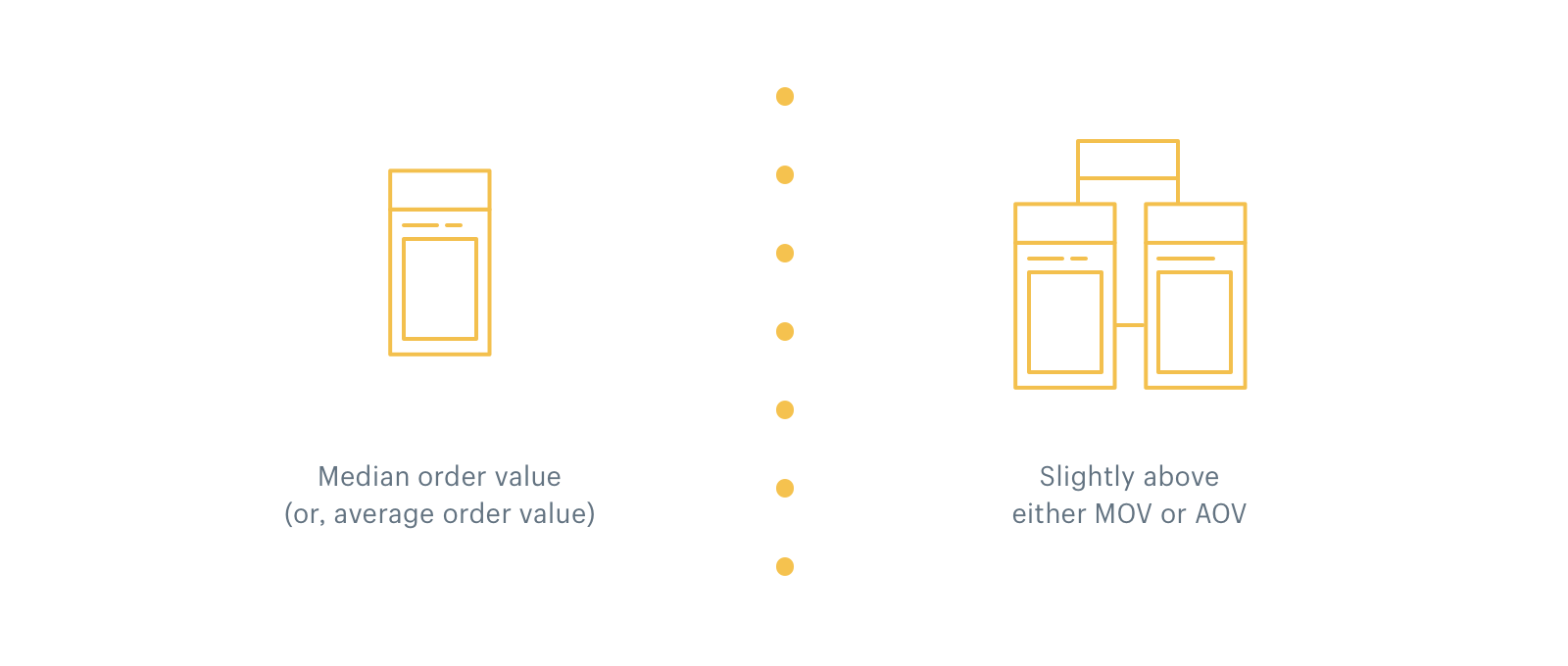
Ideally, free shipping is set just high enough above your median order value or average order value that it nudges customers to add one or two extra items they were previously denying themselves.
To figure out the threshold, you can also consider:
- Your standard shipping costs: These can be affected by average box size, geography, and the weight of the products you’re sending out. Determine both what you’re charging customers, as well as what’s being charged to you by carriers.
- Any other fees you pay on transactions, such as customer duties or credit card fee. (If you’re selling to or from the U.K., .)
- The cost of the products, packaging and your profit margin: How much of a hit are you willing to take to your overall profit?
- Your AOV: However, keep in mind that there may be outliers, such as extremely high or low-price SKUs that can distort the value of your median cart.
Once you’ve got some numbers to work with, you can run a standard A/B test on your site to determine the sweet spot at which you can boost both conversions and profit. Then, it’s time to embed your threshold throughout the customer shopping experience, such as by adding this free progress shipping toolbar, which makes the bonus tangible for consumers as they shop.
This is how glasses brand Peepers increases conversions and average order value: They offer set free shipping at just under two pairs of glasses, pushing customers to order more than a single frame:

As soon as you add an item to cart, Peepers incentivizes the move to free shipping with an in-cart upsell:
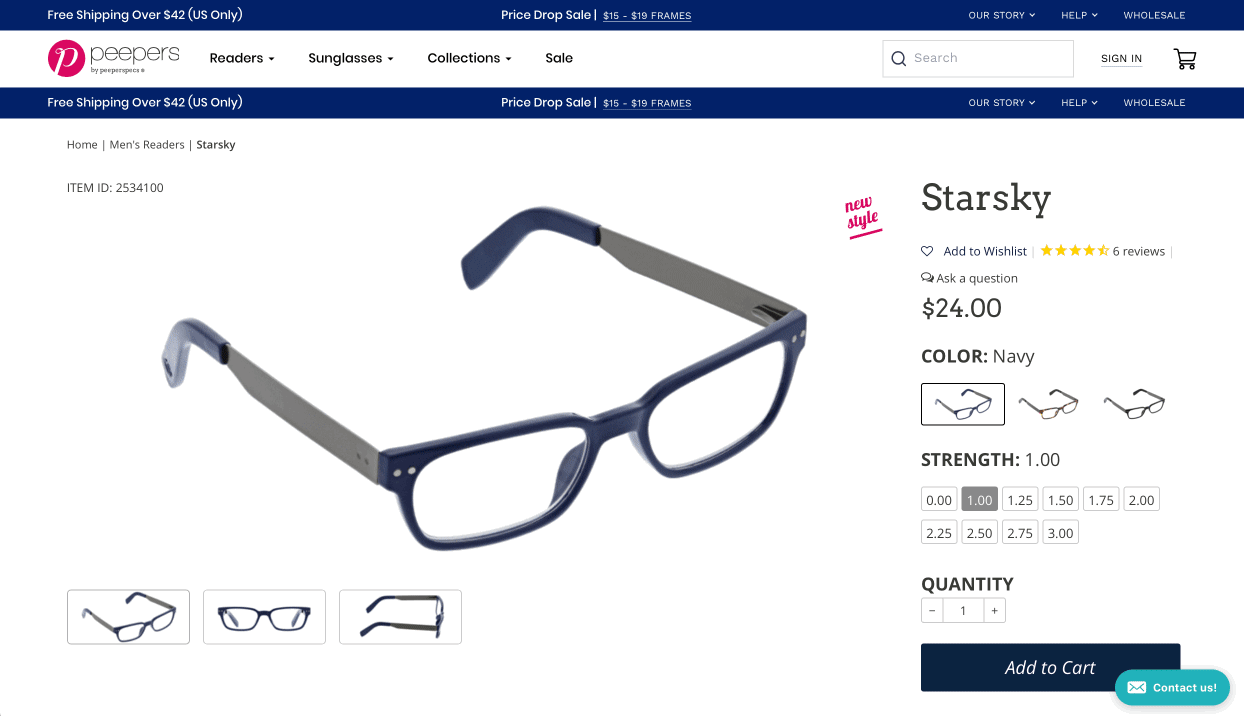
Experiment with different thresholds above your median order value or average order value to find the threshold that performs best. There’s never a silver bullet for conversions: When you mix in variables such as price, images, and product innovation, these factors will all ultimately influence customer behavior differently. Routine testing may prove that you can steadily increase your threshold once higher thresholds are accepted as the norm.
Embed the threshold throughout the customer experience—including not-so-subtle reminders during the checkout to coax more shoppers to add items to their carts and earn the free shipping you’re offering.
Bombas takes a similar approach:
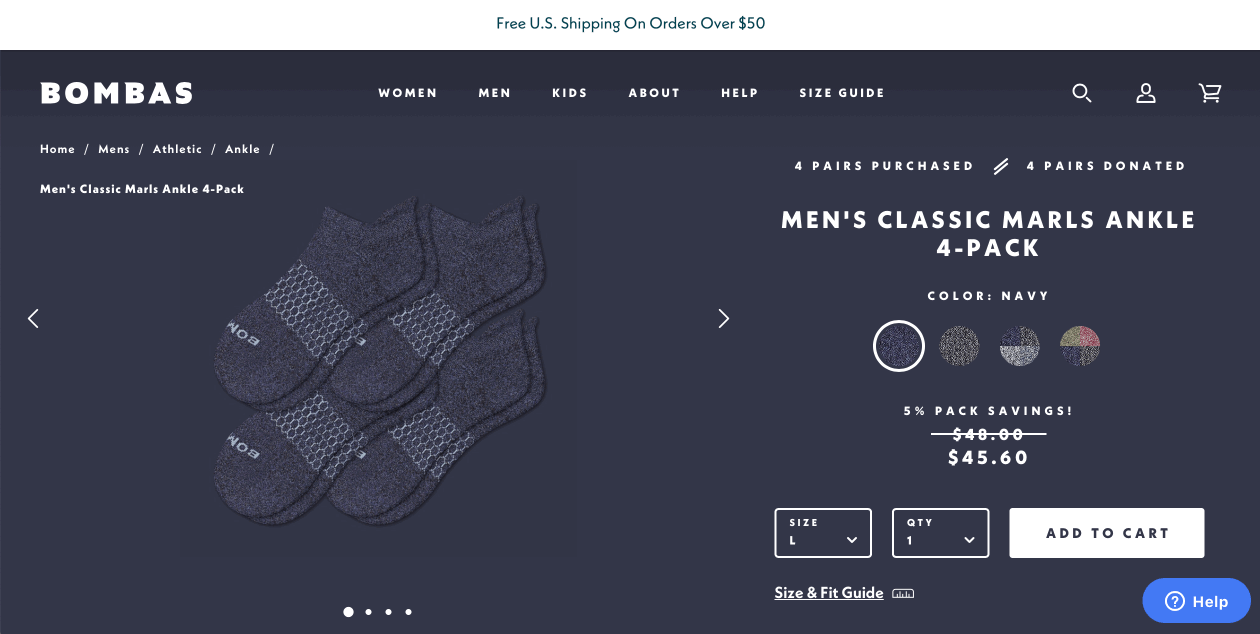
On mobile, Fashion Nova places their free-shipping threshold front and center across the purchase journey, with real-time reminders of exactly how much someone needs to add to their cart to qualify for free shipping:
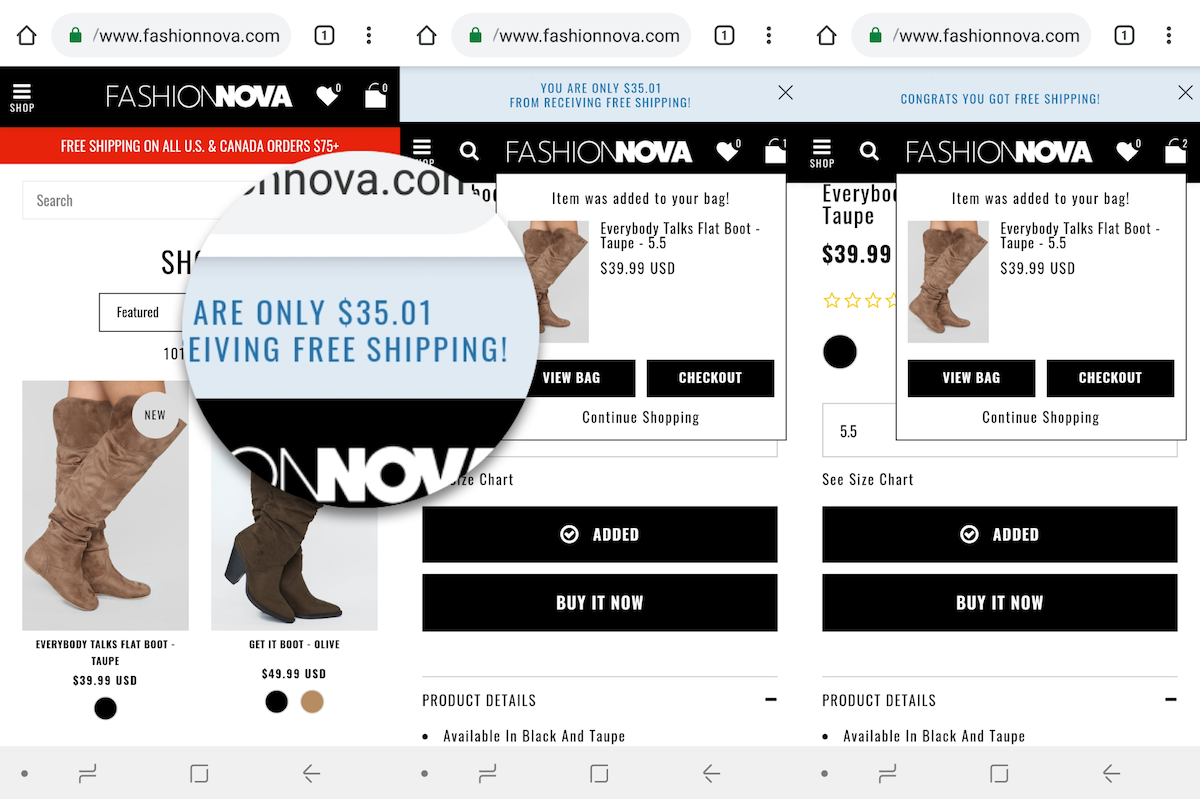
The above examples all use Shopify Scripts alongside UX customizations to automatically trigger free shipping without a discount code. You can check out five Shipping Script templates here for inspiration or learn more about creating Shipping Scripts here.

One of the challenges of automating free shipping is making sure it only applies to the least expensive shipping option. If customers were to add priority or overnight shipping for small orders, it would seriously lower margins.
To address this, Brian Harder, the IT Director at Oxyfresh, “built a fixed-amount discount code with a discount value of $0, he says. “Doing this allowed us to utilize the minimum purchase requirement and also limit the use to one per customer without the need to do custom programming.
“Using Shopify Scripts, I was able to create a new shipping script that would look for the discount code ‘SPOOKY’ and if the code was present it would set our standard shipping method to free while our second day, next day, and international shipping options were exempt.”

Your own free shipping threshold should:
- Give consumers rational “permission” to add more items
- Act as a positive incentive to “earn” something of value
- Lean on the potentially negative experience of paying for something they’re used to getting for free
Should I offer free shipping or a discounted price on a product?
Consumers love getting something for nothing, which is exactly why free shipping works. But given that “free” shipping still comes at a cost, it might leave you wondering what’s a better strategy: Offering free shipping, but charging a higher product price to cover the difference? Or charging for shipping and offering products at a lower price?
Unfortunately, there’s no clear answer to this question, as it depends on a number of variables. For example, if you carry exclusive or premium products with an intentionally higher price point, selling them at a discount can do your brand a disservice.
If you’re ready to do A/B tests to determine what your customers best respond to, there is one piece of research worth paying mind: According to a Harvard Business School study, shoppers are only one-tenth as sensitive to increases in shipping fees as they are to product price increases.
Shoppers are only one-tenth as sensitive to increases in shipping fees as they are to product price increases.
“So there’s room for merchants to experiment with different value combinations,” suggests the study’s authors.
Don’t forget to revisit your shipping policies
As the Harvard researchers write, in order to determine what combination results in the highest profit margins, you’ll have to experiment with different thresholds above your MOV and AOV to figure out what performs best.
But key to this, is understanding that it may not perform in perpetuity. You may be able to increase your threshold (once thresholds are accepted as the norm by return customers) or may need to lower them. Determining your best practices for shipping and free shipping thresholds isn’t a matter of “set and forget.” Regardless of the strategy you choose now, it’ll need to be revisited down the line.
Pinpointing the ideal threshold is just one component of turning ecommerce fulfillment into a growth driver for your business. Persuading consumers to spend more in return for free shipping will only inflate margins if you can optimize fulfillment.
To do that you must begin thinking inside the box—how shipping container dimensions and the size of your product offerings may be better matched.
Doubling your margins with a box
Just like traditional business metrics, the numbers associated with shipping container geometry and pricing are constantly changing, and generally not in ways that are helpful to your bottom line. It might even feel overwhelming trying to keep up on the latest changes:
- UPS increased rates by an average of in 2021, with the largest increases for oversized and heavy packages
- FedEx also increased its freight shipment rates from $0.10 to $0.35— which disproportionately affects online sellers that sell internationally
- The USPS’ increased rates for shipments are at an average of 4.9%, depending on the size of the box
Despite the rate hikes—which may not look like much on the surface but can be material for low-margin offerings or if you experience high return rates— high-volume brands are increasingly looking toward flat rate shipping margin erosion.
The goal is to convert a portion of their variable shipping costs into fixed costs that allow them to better plan, manage, and execute.
You might further improve your bottom line by discovering how to getcustomers to add more items that fit inside flat rate shipping containers that allow you to:
- Offer “free freight” on your terms
- Fix and control shipping costs
- Increase certainty and visibility
- Test thresholds to find the sweet spot
It’s all about the geometry of the container, the mix of products that can fit inside that container, and the data-informed free shipping threshold you’ve identified that makes this combination just as valuable to you as it is for the customer.
Below is a real example from ShipHero, which offers a mobile warehouse management system that helps merchants manage inventory, pick, pack, and ship.
While we’re not at liberty to disclose the name of the business in this example, ShipHero’s Adam Rosenberg paints a picture for us of a store owner using ShipHero that sells soap and at times holds flash sales to move inventory.

The flash sale looks something like this: a 6-pack of soap is discounted to $25 and delivered within 24 hours.
Here’s a detailed snapshot of exactly how that original flash soap sale breaks down when shipping costs are calculated with the cost of goods sold.
Current method:
The products cost $1.73 a unit, the packaging costs $0.60 per six pack for a total weight of slightly less than two pounds. So with cross-country freight costing $9.69, it leaves a gross profit of $4.53.
- Selling price: $25.00
- Product: ($10.38)
- Shipping: ($9.69)
- Box: ($0.40)
- Gross profit: $4.53
Typically, a 24-hour sale will result in 800 units sold and total $3,624 in gross profit with the merchant paying $4.16 per unit delivered.
But look what happens to demand and profitability when you adjust your product offering to better fit a flat rate shipping box:
Better way:
The store owner changed the sale to a five pack and lowered the price to $20 delivered to the end-customer because a 5-pack fits in a Priority Mail Flat Rate Box which costs $6.25.
This lowered the cost for the store owner from $4.16 delivered to $4.00 delivered and reduced the overall ticket, making it more attractive for prospective new customers.
- Selling price: $25.00
- Product: ($8.65)
- Shipping: ($6.25)
- Box: ($0)
- Gross profit: $5.10
“This increased the gross profit per sale to $5.10, and sales increased from 800 units per sale to 1,400 units per sale,” says Rosenberg. “Those changes increased gross margins from $3,624 to $7,140—a 97% increase in gross profit for the sale—simply by matching the product offer to an efficient shipping size.”
So even at a lower price point, the adjusted offering is significantly more profitable, in part, because the soap company is enticing customers to check out with a cart of goods that fits neatly into a flat rate box.
Optimizing average box size
You’re trained to obsess over shipping costs, but size, weight, and zone considerations can combine to create a myriad of choices that can cause analysis paralysis and leave you thinking that gaming the shipping game is next to impossible. Even though there are tools you can use to instantly compare real-time shipping quotes from a variety of freight haulers, you can dramatically simplify a significant portion of your orders by changing your mindset.
Instead of focusing on shipping costs, take a look at shipping container size.
Unfortunately, you’ve also been taught to first look at the shipping container sizes offered by your logistics partners. While that’s important, it’s not where your initial focus should be directed. Once again, none of that data is pertinent until you reverse the process and look at your own data.
What’s your average box size?
Average box size (ABS) is one of the new numbers that next-generation ecommerce businesses obsess over. Only after you know your ABS can you:
- Compare your ABS to the size of flat-rate shipping boxes
- Determine how much space is left in those flat rate boxes
- Identify incentives that persuade people to add more items to that box thus lifting margins for the same flat shipping rate
Note: What we’re condensing in this post for you is the result of much trial, error, and A/B split test experimentation. The merchants generous enough to share these insights, some of whom preferred to do so anonymously, may seem as if they are giving away a competitive advantage.
While that may be true in the short run, shipping rates, ABS, and the size of best-selling products are constantly changing meaning the process of matching the right offering with the right container at the right price is one that is continuous and without end.
Creating your own free shipping program
Your starting point will differ depending on how involved you are with fulfillment.
But regardless of whether you ship and fulfill from your own warehouse or partner with a 3PL, you can better match product offerings with shipping containers when you treat your products and the containers in which they may be shipped as a puzzle that can be put together in a variety of ways.
Here’s an outline of a process to get you pointed in the right direction:
- Leverage your business intelligence platform or 3PL partner to identify your average box size
- Assign a numerical value to each product so you can quantify the size of your products for mix and match shipping container comparison purposes
- Analyze products that are commonly purchased together and compare with shipping container geometry to identify inefficiency or empty space
- Optimize around your average box size by adjusting your offering, promoting upsell and cross-sell opportunities, and free shipping thresholds
Once you know your ABS, you can quantify the size of your better selling items, the best selling combinations of those products, and how they fit into flat rate boxes. You’ll also likely have a new AOV which you can use as a basis to test new shipping thresholds and compare conversion rates.
Optimizing shipping by outsourcing to a 3PL
You may have identified the optimal free shipping threshold, and you may be optimizing around your ABS. But getting that box to customers in two days often requires a network of fulfillment centers scattered across the globe—or at least relatively close to the geographies from which the majority of your orders originate or are to be shipped.
Outsourcing fulfillment to a 3PL (third-party logistics) with a network of fulfillment centers scattered across the country not only allows you to compete with Amazon but also positions you to slash costs and lift profit margins. Some also offer epacket tracking, which allows your customers to check in on the status of their order at any time.
Partnering with a fulfillment company offers many advantages. Not only does it offload the time and stress of managing logistics in-house and afford the opportunity to scale fast and successfully. It also helps keep shipping costs down.
Here are a few ways 3PLs make this possible:
- 3PLs handle large volumes of shipments across thousands of businesses to provide steeply discounted rates with all carriers and services
- You can use your own custom-branded boxes or use the 3PL’s standard boxes, packing expertise, and
- 3PLs have a strategic geographic footprint, so you don’t need to invest in the infrastructure yourself
- Neither do you need to pay for warehouse equipment, utilities, technology, staff nor worry about complying with regulations and obtaining licences
- Lastly, you can optimize where you store your inventory within the 3PL’s fulfillment network and more easily expand into new markets
How geography impacts shipping costs
In the 3PL world, there has been a shift toward urban areas to be near the majority of the buying power, as compared to the older, more traditional rural warehouse model. This allows for ground shipping across shorter distances, which is much cheaper than air shipping.
As you use more fulfillment centers that are near customers, the zones shipped to are lowered along with costs. The greater the shipping zone or distance a package travels, the more expensive it will be—that’s why the use of one fulfillment center or warehouse can be limiting.
The map below of the continental US shows an example of a fulfillment center in Los Angeles, CA (as indicated by the yellow star). The legend shows shipping zones spanning from 1 to 8, and the map is color-coded by shipping zone. Orders shipped from the west coast of the United States to east coast would be shipped to the most expensive zones.
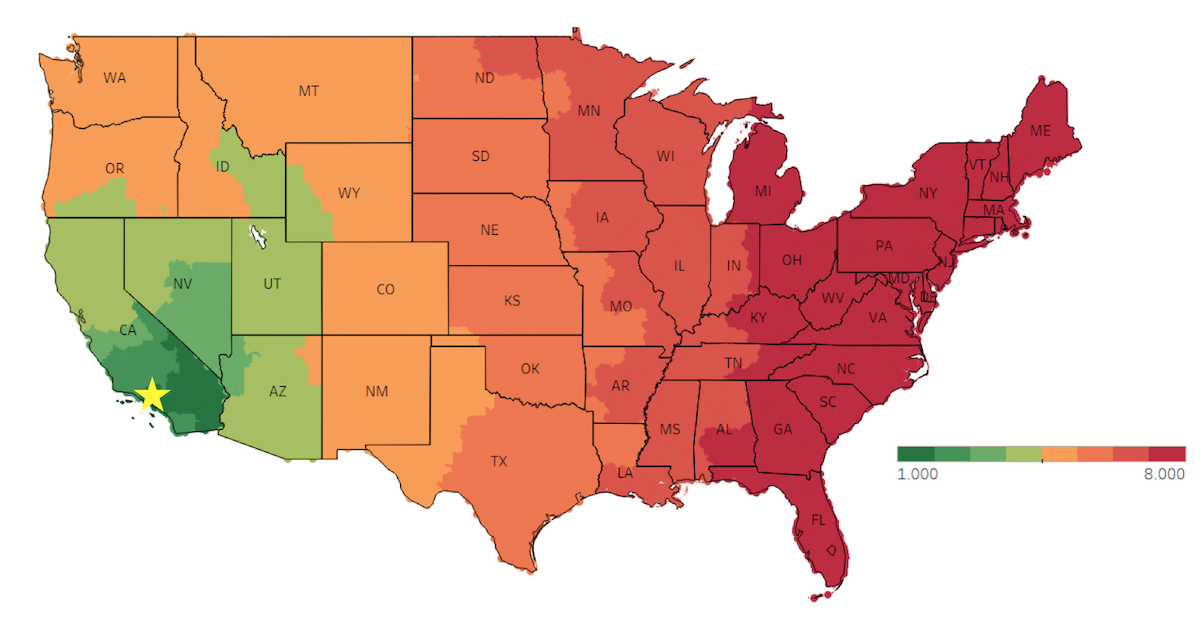
If we look at another map of the continental US below with three fulfillment centers in Los Angeles, CA, Dallas, TX, and New York City, NY, we see that the highest shipping zones are eliminated entirely.
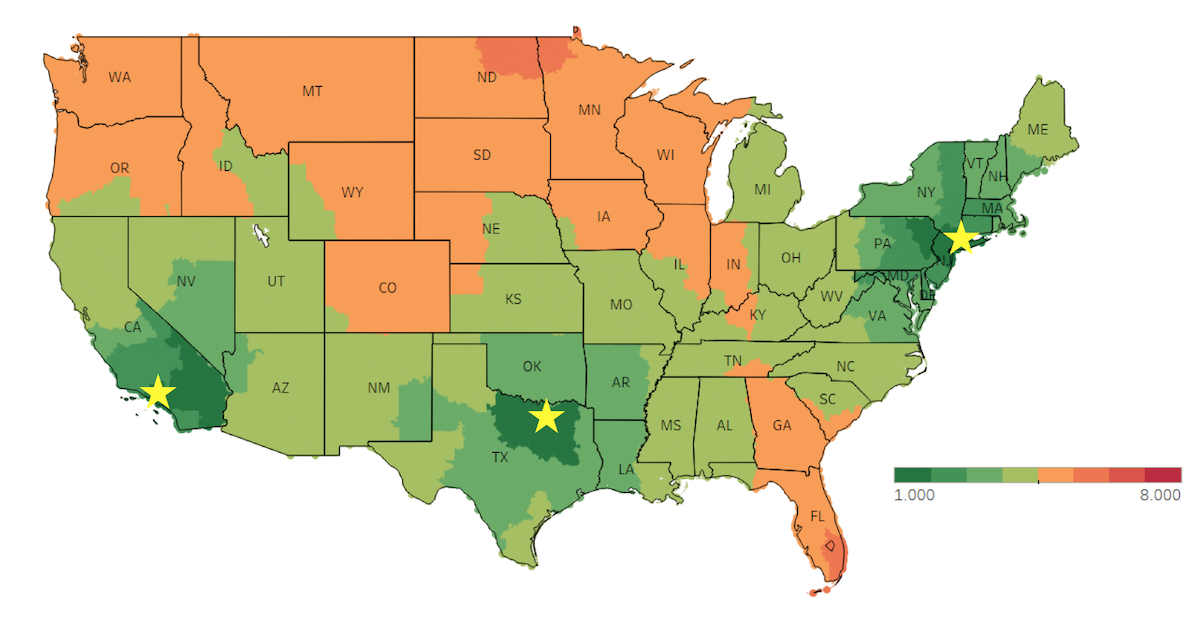
This keeps costs down when shipping to the majority of the United States.
Fortunately, 3PLs are becoming more modern and technology is driving greater efficiencies and optimizations. ShipBob, for example, has a guaranteed 2-Day Express Shipping Program for Shopify Plus businesses that integrate their store with ShipBob and have their inventory in ShipBob’s fulfillment centers.
After a customer enters their shipping destination, ShipBob validates the zip code and items ordered against inventory counts in each ShipBob fulfillment center in real-time. Only customers whose orders qualify for the discounted 2-day shipping option will see the new shipping option, and the order will be shipped from the fulfillment center that is closest to the shipping destination.
There’s no one right way to offer free shipping that works to increases profit margins. Whether you outsource ecommerce fulfillment or do-it-yourself by optimizing around your ABS, turning fulfillment into a competitive advantage requires creativity and discipline.
To illustrate what this looks like in the real world, three high-growth businesses are revealing exactly how they optimize fulfillment so you’ll have a rough blueprint you can use to turn your ecommerce fulfillment into a growth driver in similar ways.
Learn more: [Global Fulfillment] A Guide to Finding the Right Shipping Partner
How Rhone builds bundles to scale faster and efficiently
Pre-bundling items that are often purchased together (kitting) can help you lift AOV and reduce shipping costs. It’s a fulfillment technique that can both work for businesses that fulfill orders themselves and those who outsource the job.
Building kits in bulk, based on customer purchase histories and trends, can help businesses who fulfill orders themselves save time. Merchants who outsource fulfillment can save time and money as a bundle will count as only one SKU rather than two.
This is exactly what Rhone, a premium men’s fitness apparel and activewear manufacturer, is doing with its kits. The curated collections include bundled basics for underwear, T-shirts, and socks.
The bundles offer customers multiple products at a value price. Thus, Rhone decides the bundle size and the best shipping container to ship them in. The kits also position the company to test and optimize its shipping threshold which has improved conversions and revenue per visitor.
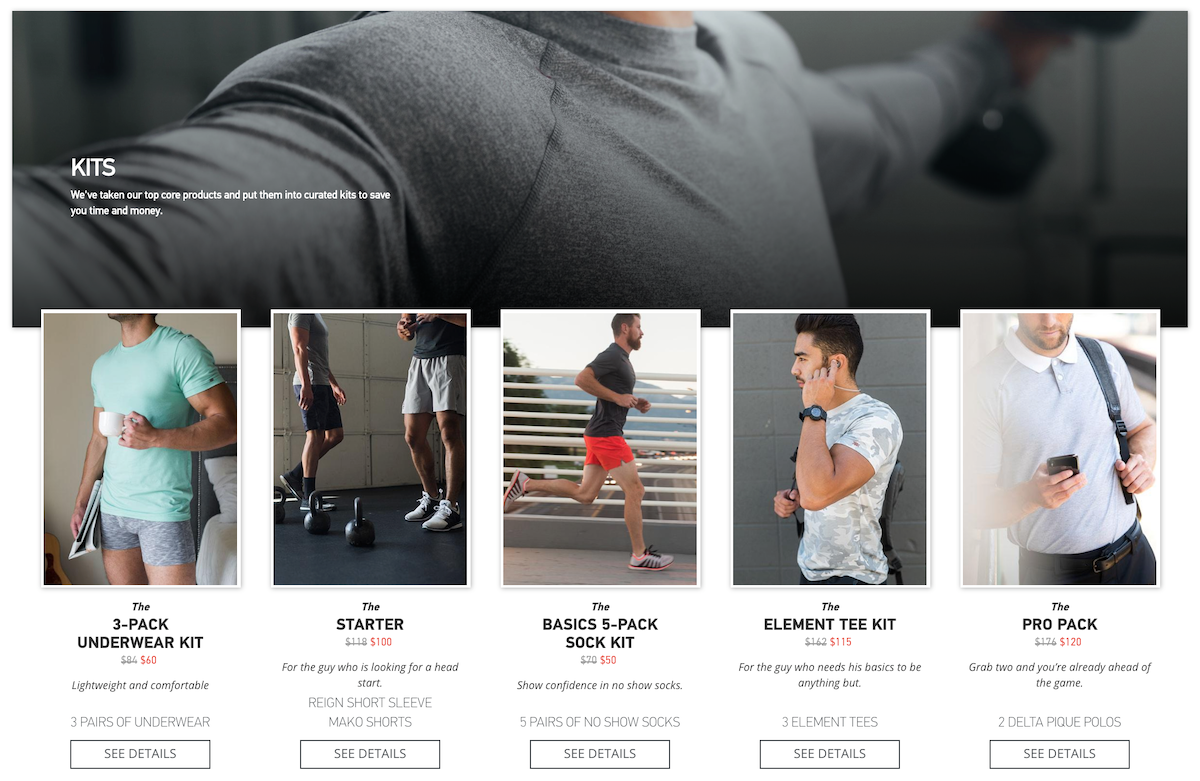
“The Kits allow us to maintain the cart sizes (more than one item) and is better than shipping out two separate orders,” says Adam Bridegan, Rhone’s V.P. of Digital.
“I think it’s just about getting creative on the shipping side while continuing to serve customer expectations. We’ve also done a gift with purchases at certain cart sizes to help increase AOV and thus help us with packing more into shipping boxes.”
Some of the businesses generous enough to share their insights with us have hundreds of SKUs. This can make for a seemingly infinite number of combinations that fit into an average box size or a single flat rate shipping container.
Don’t become fixated on fitting every order into a single flat rate box. Remember, we’re dealing in averages and best sellers here. The idea isn’t to force every customer to do what is most convenient for you. The real point here is that it is possible, even with a large number of SKUs, to optimize a significant portion of your orders—not all of them—around your shipping container of choice.
How The Emazing Group optimizes packaging
Brian Lim, founder of EmazingLights, started a multimillion dollar business out of the trunk of his car and scaled it from $15 to $30 million in annual sales in just three years, in part, by optimizing product packaging and fulfillment.
But the LED gloves Lim sells to performers are frequently shipped in packaging that has been redesigned to be shipped more efficiently.
In fact, adapting product offerings based on shipping container geometry is an analysis Lim, who also operates the iHeartRaves and IntoTheAM brands, conducts on a yearly basis.
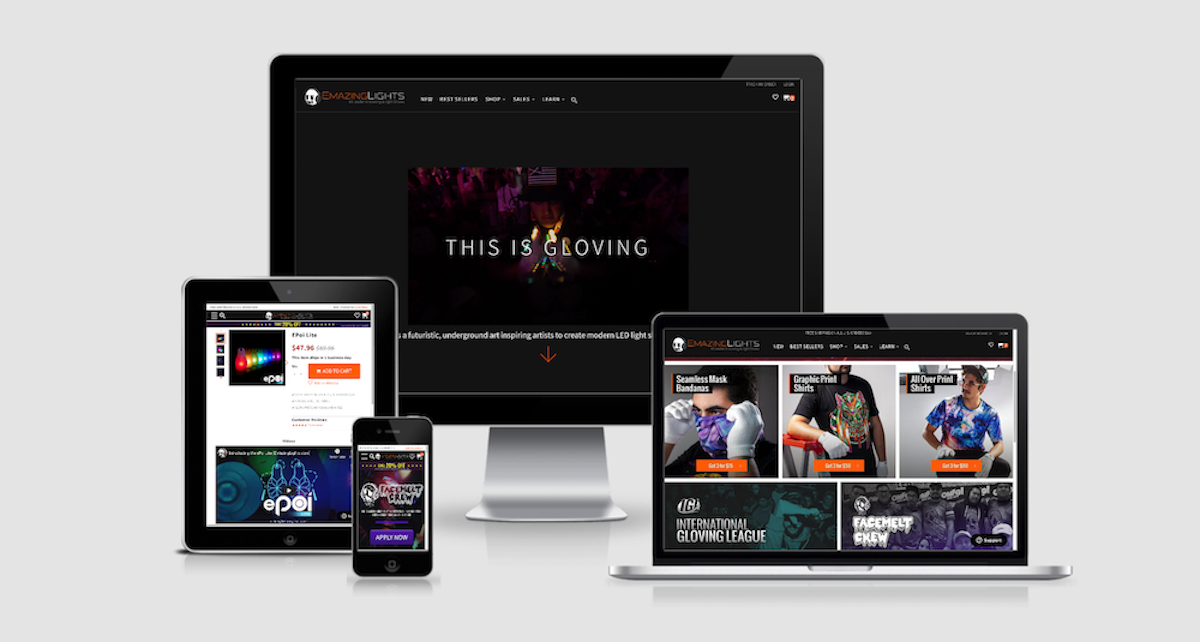
Here’s exactly how Emazing Group does it:
- Dimensions of flat-rate containers are identified and compared with best-selling products
- Packaging for best sellers are redesigned to fit inside a flat-rate shipping box
The result from this change is that Lim, for example, can ship a best seller in Zone 8 for a flat rate of $6.35 instead of $9.59, meaning Lim slashes his shipping costs 33.7% and makes an additional $3.24 per order.
Now consider that Lim expects to ship more than 256,000 orders this year and you can start to see how lucrative it can be to match your offering with the right shipping container.
“For EmazingLights more than 50% of sales are from glove sets,” Lim says. “When we designed the original box we tried to balance the packaging size for retail display, on-site vending and ecommerce. It took us about three versions to hit the sweet spot and fit the product into flat rate boxes and still look great on display.”
In all, Lim estimates approximately 50% of Emazing Lights’ orders are shipped in flat rate boxes which converts a significant amount of variable shipping costs into fixed costs.
“Yes it does really help control shipping costs and allows us to be more aggressive on lowering prices and knowing that we're not getting killed on shipping cost,” Lim says.
For Emazing Group’s lightweight items, it’s more cost-effective to ship in poly bags sourced from local vendors rather than well known national suppliers.
Emazing Group then leverages its fitted-product offering and shipping container combination by optimizing conversions through its special offers.
The brand surprises customers who reach certain free shipping thresholds by allowing them to select a free lightweight gift that doesn’t materially impact shipping costs and can fit into flat rate containers:
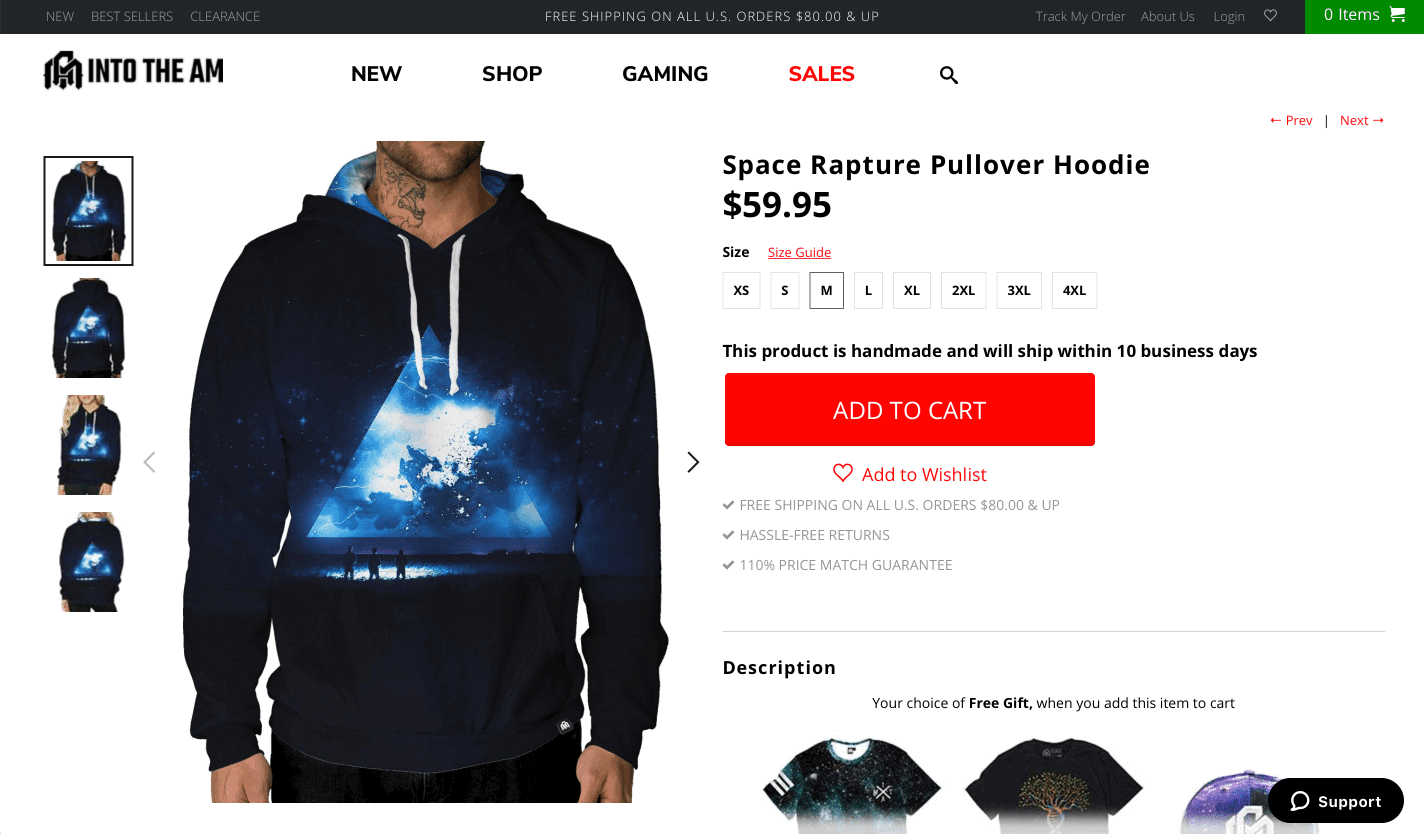
Personalizing the surprise experience with a homegrown application built with Shopify’s API technology that offers gift options based on items the customer has purchased in the past.
Secretly bundling orders with free lightweight items like drawstring bags to create a memorable unboxing experience and highlight product categories in which Lim desires to sell deeper:
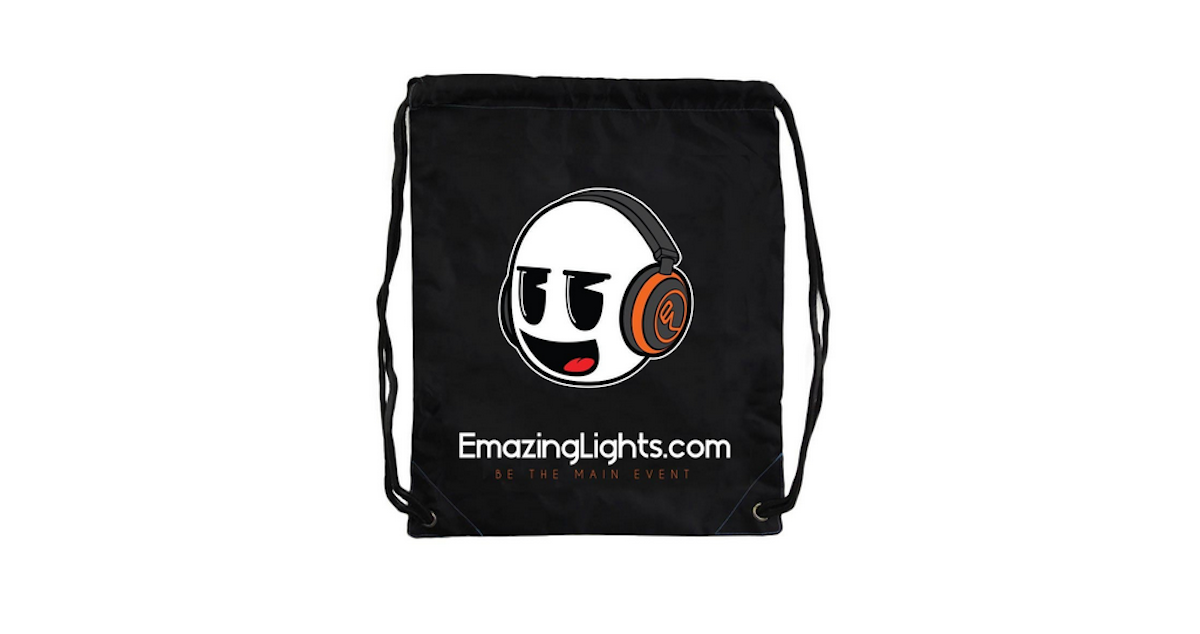
Lim combines these CRO techniques with three free shipping thresholds—$50/$60/$80—that are tailored specifically to the three brands he operates. It’s also important to note that the Emazing Group runs its own 15,000 sq. ft. warehouse and suggests it’s a competitive advantage its peers cannot match.
“It’s bootstrap-owned and self-operated,” Lim says proudly. “We use the insight from our yearly analyses to offer free shipping thresholds specific to each of our brands which has driven our average order values higher.”
How Bathorium cuts shipping costs by 70%
Shopify Plus Merchant Success Manager, Greg MacDonald, founded and runs his own store, Bathorium. Because Bathorium is based in Canada, working with a 3PL that could efficiently reach their US-based customers was critical to their success.
Shipping from Canada was very expensive and variable for Bathorium, costing about 50% of their AOV and often difficult to predict. Prior to working with a 3PL, Bathorium would spend $18 to $25 on a one-pound shipment, and it would take a minimum of 7-10 business days to reach the destination.
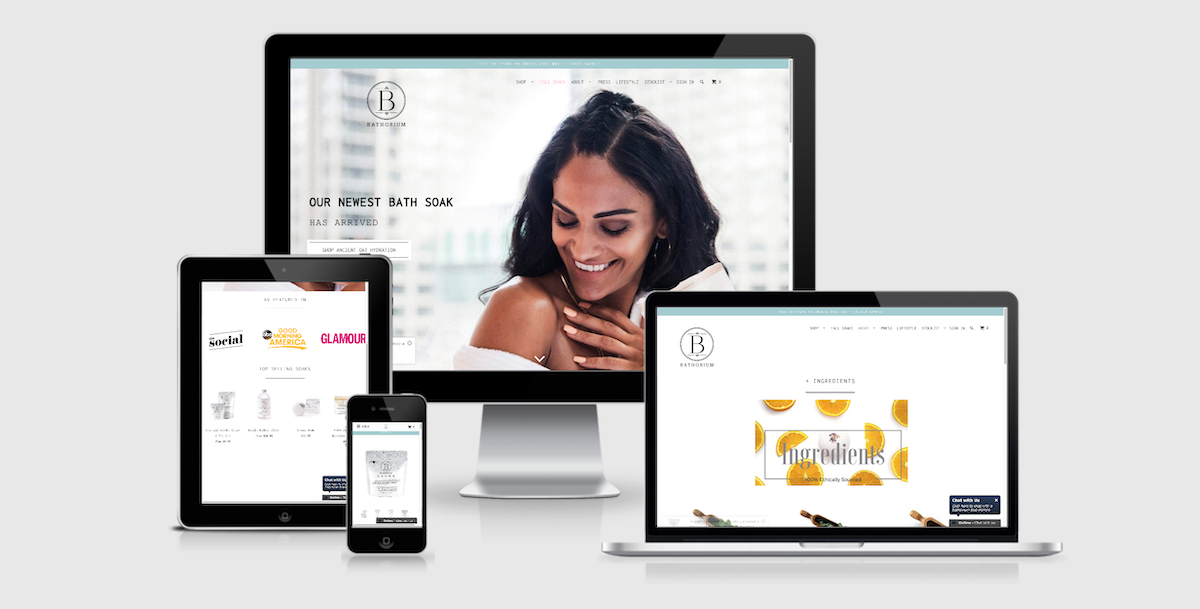
When Bathorium developed a strong US presence by partnering with ShipBob for fulfillment, they achieved a reduction of 70% on shipping costs in the US. This also led to a higher conversion rate, allowing them to grow from a 20% American customer base to 40% in under a year.
“Speeding up deliveries and keeping them affordable for customers is a top concern for us. With ShipBob, we can comfortably assign a shipping cost to each order by pinpointing the product weight and destination zip code. It makes it a lot easier to spend marketing dollars when we know exactly what shipping costs are going to be.”
Free, flat, and fast ecommerce fulfillment
Whether free shipping is actually free or whether it’s simply a perception created in the mind of customers who meet certain thresholds or conditions …
For retailers routinely robbed of margin due to unforeseen or higher than expected freight fees, flat might actually feel like free.
Even if you don’t run your own warehouse, don’t forget the following insights generously provided by businesses and vendors on the cutting edge:
- Rate shop annually and aggressively use freight carrier quotes against one another to negotiate the best possible prices
- Pre-bundle or kit items often purchased together based on purchase histories and trends to save time and increase the percentage of orders that ship in flat rate containers
- If you outsource fulfillment, a kit or bundle will often count as only one SKU rather than two which can save you even more money
- Investigate hybrid delivery services in which UPS, USPS, and FedEx work together to deliver packages for up to 50% off standard rates
Now you have everything you need to ship your orders free, flat, and fast—and leverage your fulfillment to do more than just keep up with Amazon.
Learn more: A Guide to International Warehouses in Global Ecommerce
